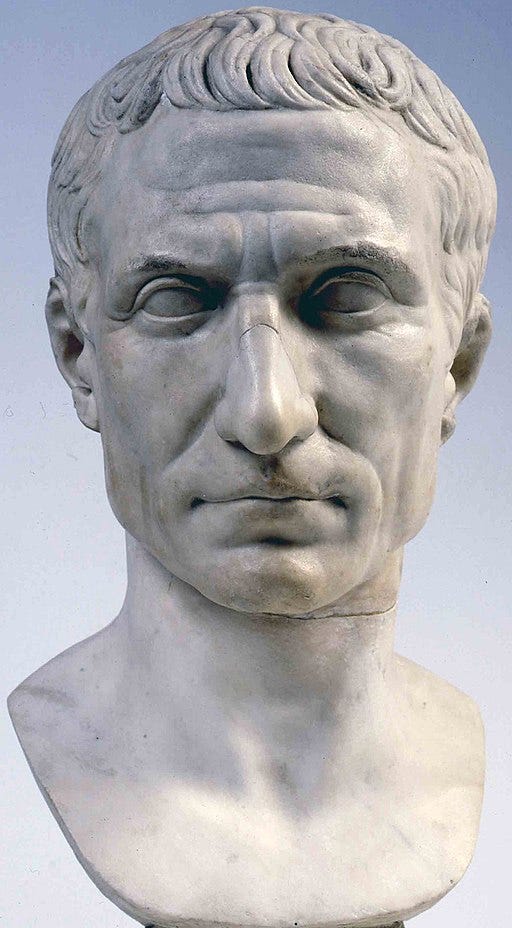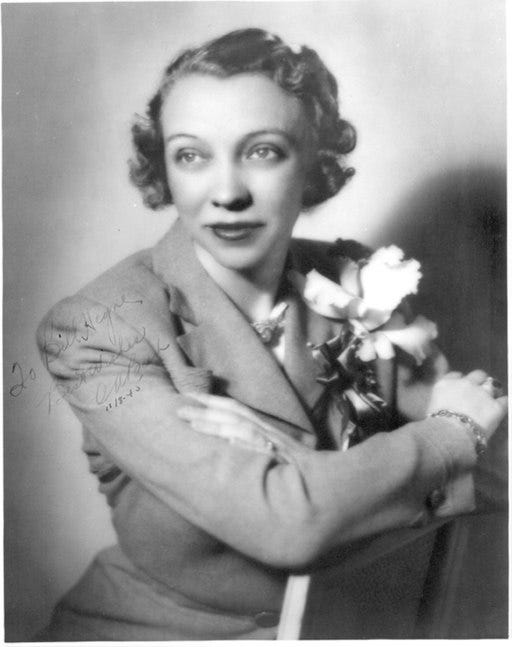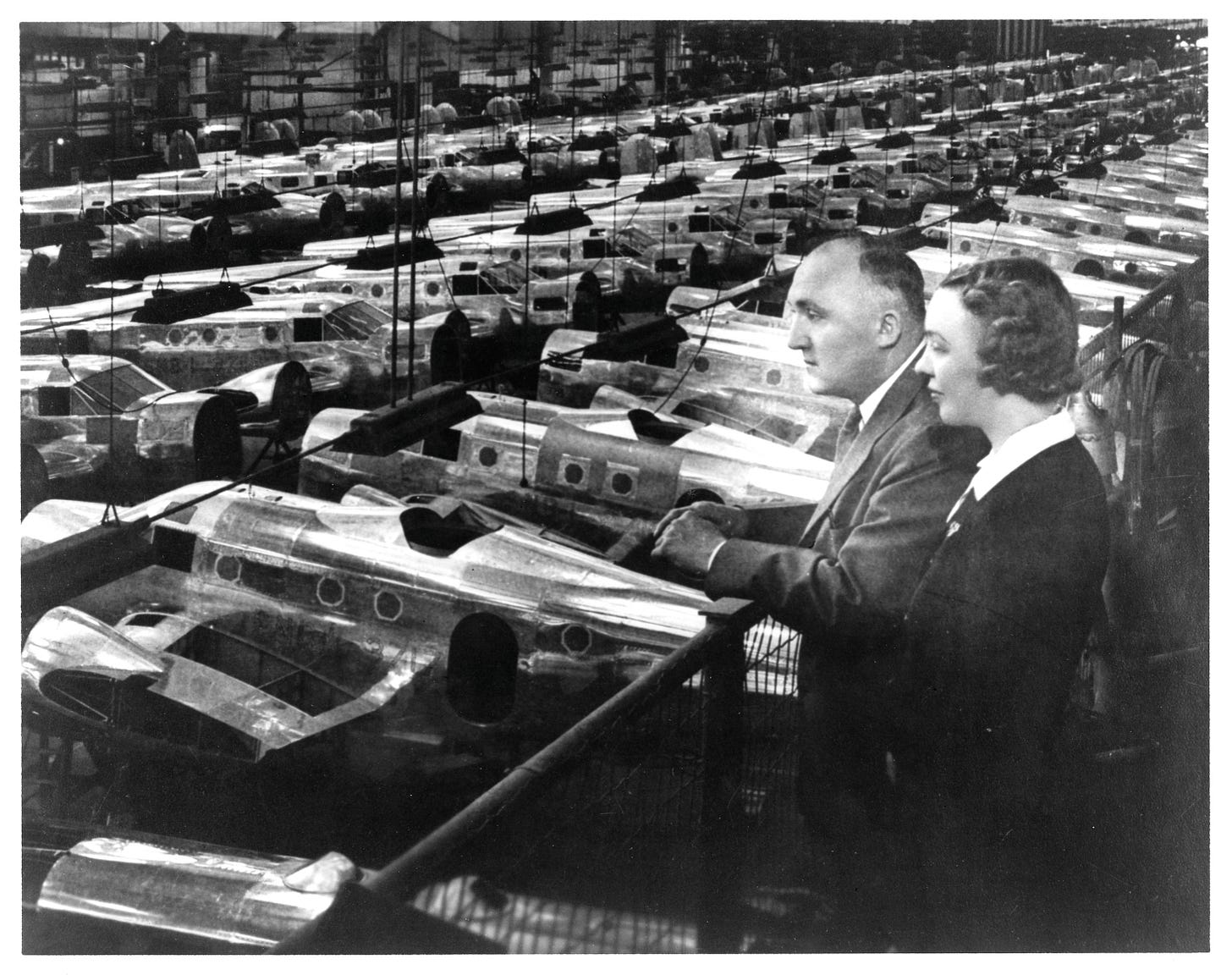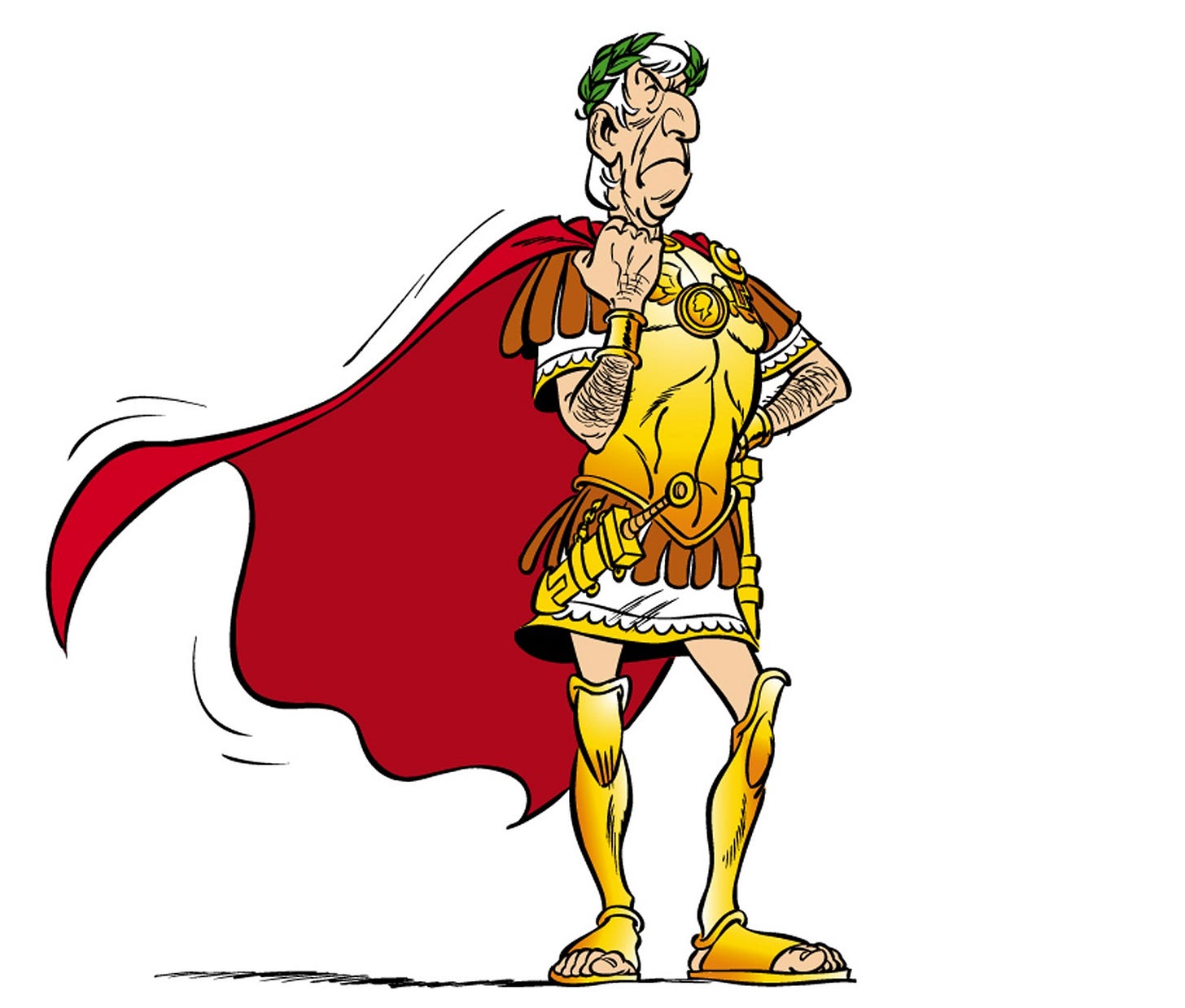Four historical figures who grabbed life by the horns
Anecdotes about Julius Caesar, Olive Anne Beech, James E. Hanger and A.P. Giannini.
Over the course of the last year of writing this newsletter, I’ve noticed that my interests sometimes follow certain themes. Biography seems to be one of them. This week I thought I’d collect and re-post some of my brief notes on the lives of several remarkable individuals.
As a young man Caesar was already “different,” as in the time he was captured by pirates.
An incident early in the life of Julius Caesar provides insight into the mindset of the man who would one day transform Rome from a republic to an authoritarian empire.
At the age of 25, Caesar was travelling to Rhodes (in modern-day Greece), where he was planning to study oratory. He was aboard a ship on the Aegean sea when the vessel was attacked by pirates.
The Mediterranean was a dangerous place then, 75 years before the birth of Christ. Pirates plagued shipping and kidnapped people for ransom, especially off the coast of Anatolia (Turkey today), where the ship carrying Caesar was making its crossing. His vessel was an easy target. The ship was intercepted. Caesar, along with the other passengers, was taken captive.
What is odd is that from the beginning, Caesar didn't behave like a hostage. He refused to accept that he was their prisoner. As the editors of the Encyclopedia Britannica have written, "The capture was a minor inconvenience for Caesar, but very bad luck for the pirates."
Taken to an island, he mocked the marauders for asking a ransom of 20 talents of silver for his life. He told them they had no idea who he was, and claimed he was worth more than double that amount. Apparently unperturbed, he arranged to send off some of his fellow passengers to collect a sum of 50 talents, while he settled in for the wait.
Accounts about his period of captivity are astounding. He is said to have participated in games and exercises with his captors. He apparently made them listen to drafts of speeches he was working on. He read them his poetry, whether they liked it or not. He treated them as his subordinates, even "shushing them when he wanted to sleep." He threatened to have them killed. They did not believe him, assuming he was joking.
Less than 40 days later, the ransom was paid and the pirates set him free. It's likely they were glad to be rid of him.
However, the story doesn't end there. Once safe in the port of Miletus, Caesar decided to pursue the pirates. Despite not having any authority as a military or political ruler, he found a way to raise a naval force. Remember, he was only 25 years old. He returned with this force to the island where the pirates were still encamped and had them captured. While the regional governor was deciding what to do with the captives, Caesar decided to take matters into his own hands. He went to the prison, had them rounded up and then crucified. Not a happy end for them.
A few years later, Roman forces occupied the island of Crete and from there they were able to put an end to piracy in the Aegean.
Like Napoleon after him, Caesar seems to have been imbued with supernatural confidence in his own abilities and a sense that the rules that apply to other mortals somehow did not apply to him.
Fascinating and frightening, highly intelligent and unusual, people like Caesar, Napoleon and a handful of others in human history motivated millions to do their bidding, for better and often for worse.
More info:
https://www.britannica.com/story/the-time-julius-caesar-was-captured-by-pirates
https://www.ancient-origins.net/history-famous-people/julius-caesar-kidnapped-0011344
~~~
Olive Ann Beech, trailblazer
In the aviation industry, pilots are not the only people who soar. High achievers leave their mark in a number of other roles, too. Olive Ann Beech was one of those special people, a talented leader who become the first woman to run a Fortune 500 company.
Her story is worth telling.
In 1932, Olive Ann (Mellor) Beech and her husband, Walter Beech, co-founded the Beech Aircraft Corporation in Wichita, Kansas. Walter Beech was a pilot and an experienced entrepreneur in the airplane industry, having previously worked with Clyde Cessna in a venture called Travel Air Manufacturing.
During the Depression, starting an aircraft company was no easy feat. Fortunately for Walter Beech, Olive Ann was skilled in finance and management. While Walter focused on aircraft design, something he did very well, Olive Ann ran the day-to-day operations of the firm, something at which she, too, excelled. They had met at Travel Air, where Olive Ann worked in the main office.
However, when Olive Ann started out in the business, things were not so easy for her. She was teased by the Travel Air employees for her lack of knowledge of aviation.
When I first started working at Travel Air, I didn't know the empennage [tail assembly] of an airplane from the wing. After a great deal of teasing from the staff when my letters were confused, I had our own chief engineer give me a complete breakdown drawing of an airplane.
- Olive Ann Beech
The first aircraft built by Beech Aircraft was the Model 17, which entered into production in the early 1930s. The plane became known as the Staggerwing, for the unique design of its offset double wing. It was one of the world's first executive planes, practical and advanced for its time. Fast and sleek, with an enclosed cabin, these aircraft also were called "limousines of the skies."
As orders for the Staggerwing started coming in, Olive Ann balanced the books, handled payroll and worked on long-term planning.
As aviation was developing In the 1920s and 30s, airplane races became quite popular. In 1936 the company decided to enter their Staggerwing in one of the most prestigious events, the Bendix Transcontinental Trophy Race, from New York to Los Angeles. Olive Ann thought it would be a good idea to hire two female pilots to fly for Beech. She believed it was an opportunity to demonstrate the quality of the aircraft. She wanted to show that, unlike other airplanes to the era, it was a well-engineered airplane and did not require brute strength to operate. She also wanted to prove, of course, that women were just as capable at flying as men.
Olive Ann selected Louise Thaden and Blanche Noyes to pilot the Staggerwing. Their aircraft crossed the finish line in a time of twenty-four hours, fifty-five minutes, beating all crews, regardless of gender. The plane that arrived second was forty-five minutes behind.
The publicity from the win helped the company to grow. One year later, Beech Aircraft unveiled the Model 18, known as the Twin Beech. This aircraft also became a classic, and many are still in use today.
The war years saw the company grow further, due to the demand for aircraft and for specialized equipment for the military.
In 1950 Walter Beech died suddenly of a heart attack, but this did not slow the company’s growth, in part because Olive Ann was elected president and chair of the board. In assuming these leadership roles, she become the first woman to run a Fortune 500 company. (The first female CEO of a Fortune 500 company was Katharine Graham of the Washington Post, more than twenty years later.)
Olive Ann continued her husband's spirit of innovation and successfully guided the firm in the development of new models, including the highly popular King Air and Bonanza. She stepped down as president in 1968, but stayed on the board of directors. In 1980 the company merged with Raytheon, and she eventually retired several years later, after more than fifty years in the business.
One of her strengths was that she knew how to find and hire good talent. Olive Ann surrounded herself with strong professionals. She also shunned the limelight and adapted a working style that gave her a level of control with which she was comfortable. Dave Stanwick, in a 2018 article entitled Olive Ann Beech: Queen of the Aircraft Industry, explained it this way:
She developed her own management techniques that were useful as a woman at the helm of a major aircraft manufacturer. She seldom held large group management meetings; when she did, she kept them short. Her technique allowed her to minimize vulnerability while maximizing authority. She ensured herself the upper hand and the home field advantage. In the morning she would scan the large stacks of mail that came in, scribbling a note on some letters: “See me.” Stories were told of grown men flinching when they were summoned by her secretary to stand on her blue carpet.
Olive Ann never learned to fly, but she won many honours and accolades, including the National Aeronautic Association’s Wright Brothers Memorial Trophy in 1980.
She died in 1993 at the age of 89.
Now known as Beechcraft, Walter and Olive Ann's company is still going strong more than ninety years after its founding. It is part of the Textron Aviation group, which also includes the equally famous company founded by their friend, Clyde Cessna.
—
Sources:
Krass, Peter (editor), The Book of Leadership Wisdom, John Wiley and Sons, Inc., 1998, pg. 102.
https://americanbusinesshistory.org/olive-ann-beech-queen-of-the-aircraft-industry/
https://www.britannica.com/biography/Olive-Ann-Beech
https://txtav.com/en/journey/articles/articles/beechcraft-a-history
~~~
The legacy of James E. Hanger
I found this to be an inspiring story of how adversity can be turned into an opportunity.
At the beginning of the U.S. Civil War, a young volunteer from Virginia was severely wounded in the first skirmish of the conflict. James Hanger, a cavalry recruit, was only eighteen when he joined his hometown militia. He was assigned to a small Confederate force guarding a railroad and a farm in Philippi, (West) Virginia. On the morning of June 3, 1861, Union forces started shelling the town. Hanger ran into a barn to get on his horse when a cannon ball struck the building and hit him. It tore off his left leg at the knee. Hanger tried to hide in the barn, but Union scouts found him some time later. His life was saved by a surgeon who amputated his leg below the hip. It was to be the first of tens of thousands of amputations during the war.
Later that year, he was returned home after a prisoner exchange. At this point, he was a severely depressed young man. He is said to have gone into seclusion in an upstairs room. But in his isolation Hanger found a way to deal with his despair. Having been fitted with a wooden peg leg, he spent the next three months conceiving and building a better artificial limb. Using staves from oak barrels, he created a prosthetic leg that could bend both at the knee and at the ankle.
Later that year, Hanger founded a company to build prosthetics for other wounded soldiers and received his first patent from the Confederate Patent Office.
After the war, Hanger moved to Washington, D.C. He continued expanding the business, opening offices in several other cities. When hostilities broke out in Europe at the start of the First World War, he opened facilities there so that his company could provide artificial limbs to the English and French armies.
Hanger died in 1919 at the age of 76. Today, the Hanger Clinic is still one of the most important suppliers of prosthetics and orthotics in the United States.
—
Sources:
Civil War Profiles: https://bit.ly/3mjlonN
Hanger clinic: https://hangerclinic.com/
~~~
How a manager who preferred answering the telephone himself founded the largest bank in the world.
This is the story of A.P. Giannini, the founder of Bank of America, a man who at the dawn of the 20th century preferred an open office concept and always answered the telephone himself.
Giannini was born Amedeo Pietro (Peter) Giannini in San Jose California, in 1870. He was the son of Italian immigrants and began his business career selling fruits and vegetables from a horse-drawn wagon. At the relatively young age of 34, he launched a small bank in an Italian neighbourhood of San Francisco. Unlike the other banks of the day, that catered almost exclusively to wealthy clients, Giannini focused on providing services to immigrants, convincing them to store their savings in a vault and offering interest, dissuading them from stashing their money away in improvised hiding places like mattresses.
He called his California bank the "Bank of Italy."
A turning point occurred in April of 1906, when San Francisco was devastated by the great earthquake. In the chaos and anarchy of the next few days, financial institutions across the city closed. A fire had engulfed hundreds of blocks, levelling many buildings and burning for days. According to one account, the metal vaults in the large banks had been overheated by the flames and could not be opened for weeks for fear that currency and documents might catch on fire when the doors were opened and oxygen rushed in.
Giannini saw an opportunity. The day after the earthquake struck he borrowed a desk and set up a makeshift office on a wharf, even as the fire still raged in many parts of the city. He provided loans to desperate residents "on a handshake" and his fame grew as the city revived.
Giannini had a vision for banking. He wanted to make financial services affordable and accessible for average people, and as his business grew, he explained his goals: "The bank of tomorrow is going to be a sort of department store, handling every service the people may want in the way of banking, investment and trust services."
He roamed small towns across California and created branches in many of them, offering credit at cheaper rates. His bank established the first statewide branch system in the country.
Giannini’s work habits were interesting. He preferred open concept office spaces and always answered the telephone himself.
… I have no assistant who could be called a private secretary in the ordinary sense. To be sure, I have assistants who attend to various matters. But their tasks are more their own tasks than mine. I do not need the services of a a private secretary to look after my appointments, for the very good reason that I have none to amount to anything. I tell anyone who wants to see me to come in at any time, and I try to see him without keeping him waiting unduly.
I find that by answering the telephone myself I can often settle a matter definitely which might otherwise require a personal interview.
I attend to correspondence as opportunity permits. It is not often that I find a problem so knotty that I must concentrate on it undisturbed. In fact I have often noticed that knotty problems often seemingly solve themselves if the subconscious mind is given an opportunity to work on them. I find that by just going ahead with less important tasks — seeing those who want to see me — difficult decisions often work themselves out, and to better advantage, perhaps, than if I had made a more conscious effort.
In 1930, the Bank of Italy in San Francisco became Bank of America. And when A.P. Giannini died in 1949, it had become the largest bank in the world.
—
Sources:
"I Answer The Telephone Myself," is featured in The Book of Leadership Wisdom, by Peter Krass, 1998, published by John Wiley and Sons, Inc., pages 330-333.
Article: Bank of America: The Humble Beginnings of a Large Bank. https://bit.ly/3HrAWNg
~~~
Artwork by Albert Uderzo
Back to Julius Caesar for a moment. I recall the impressive artwork of the Asterix comic book series, penned by the illustrator Albert Uderzo and his writing partner, René Goscinny. This talented pair seem to have given us a pictorial rendering of Caesar that appears faithful to historical accounts. Here’s a sample:
Thanks for reading Zanepost. If you know anyone who might be interested in this newsletter, please share it.
Warm regards, Renato Zane.













